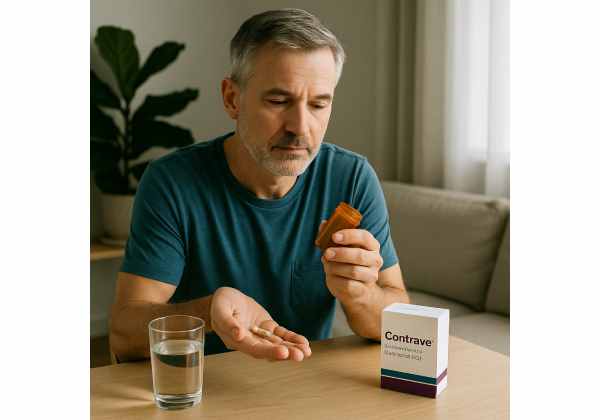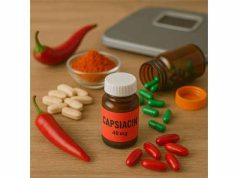
Choosing a weight loss medication is easier when you know what each one actually does, how much weight people typically lose, and who tends to benefit. Naltrexone-bupropion (brand name Contrave) combines two older medicines to target appetite and reward pathways that make overeating sticky. It is not as powerful as GLP-1 injectables, but it can help the right person lose a clinically meaningful amount—especially when paired with nutrition, movement, sleep, and coaching. Below, you will find how it works, a week-by-week dosing schedule, realistic results, safety rules, and a decision framework to judge whether it is worth continuing by week twelve. For a wider view of options, see our guide to medical and supplement options.
Table of Contents
- How naltrexone-bupropion works for weight loss
- Who it suits and who it doesn’t
- Dosing schedule and safe start
- Expected results by week and month
- Common mistakes and fixes
- Side effects, interactions, and warnings
- Comparison with other medications
- Frequently Asked Questions
How naltrexone-bupropion works for weight loss
Two ingredients, two targets.
Bupropion is a norepinephrine- and dopamine-reuptake inhibitor that can reduce intrusive food thoughts, lift energy, and increase readiness to act. Naltrexone is an opioid-receptor antagonist that removes an internal “brake” on satiety signals. Together they stimulate pro-opiomelanocortin (POMC) neurons in the hypothalamus (fullness) and dampen the mesolimbic reward loop that fuels hedonic eating.
What this means in daily life.
Most people do not feel “drugged.” Instead, they notice fewer snack impulses, less “pull” from trigger foods, and a slightly earlier stop signal during meals. The medication does not melt fat by itself; it helps you follow through on a plan that creates a modest, repeatable calorie deficit.
How strong is the effect?
Average weight loss over a year is modest to moderate. Many patients see 5–9% of starting weight when they tolerate the full dose and pair it with nutrition structure and activity. About half reach at least 5% loss; a smaller group reaches ≥10%. Response is front-loaded: if you do not see early traction, continuing seldom changes the outcome.
Who tends to respond best.
- Frequent cravings or emotional eating: The reward-circuit effect is especially useful when “wanting” overrides “needing.”
- Evening snacking: The afternoon dose often blunts late-night grazing.
- Low energy or mild dysphoria: Bupropion’s activating profile can support adherence when fatigue derails routines.
Where it fits in a plan.
Use medication to reduce friction, then make three practical moves:
- anchor each meal with 25–35 g protein,
- build a produce-first plate (high-fiber volume), and
- schedule two resistance sessions weekly to preserve muscle. If you need a refresher on foundations, see our summary of safe weight loss basics.
Bottom line: naltrexone-bupropion helps you want less of the foods that keep you stuck and stop a bit earlier, turning a good plan into a consistent one.
Who it suits and who it doesn’t
Best-fit profiles
- BMI ≥30, or BMI ≥27 with a related condition (prediabetes, hypertension, dyslipidemia, sleep apnea).
- Cravings-driven eating: baked goods, candy, fast food, or late-night snacks are frequent stumbling blocks.
- Desk-heavy or irregular schedules where grazing and mindless eating sneak in.
- Individuals who prefer oral medication over injections and can tolerate a twice-daily routine.
Good-but-not-perfect fits
- Type 2 diabetes without insulin: can lose weight modestly and sometimes improve glycemic control, but GLP-1 or dual-incretin medicines often produce larger averages. If you are comparing, scan our quick explainer on GLP-1 medications.
Poor fits / likely non-responders
- Current opioid use (prescribed or otherwise): naltrexone blocks opioid receptors and can precipitate withdrawal or negate pain control.
- History of seizures or eating disorders (anorexia/bulimia): bupropion increases seizure risk; this is a hard stop.
- Uncontrolled hypertension or significant tachycardia.
- Pregnancy or nursing: not recommended.
- People seeking rapid, large losses (>10–15%) as a primary goal—other agents or combination strategies are typically superior.
What success looks like
- Behavioral: fewer urges, less “background noise” around food, smoother afternoons and evenings.
- Numeric: a trend toward ≥3% loss by week 8 and ≥5% by week 12 at the maintenance dose.
- Sustainability: tolerable side effects, stable blood pressure, no mood destabilization.
Equity and access
Naltrexone-bupropion is often covered when criteria are met and is sometimes less costly than injectables. If access or supply is limited for GLP-1s, this medication can be a practical alternative for craving-dominant eating patterns.
Dosing schedule and safe start
Formulation and tablet strength
Each extended-release tablet contains naltrexone 8 mg and bupropion 90 mg. The target dose is two tablets twice daily (total naltrexone 32 mg / bupropion 360 mg per day).
Four-week titration (standard)
- Week 1: 1 tablet morning.
- Week 2: 1 tablet morning + 1 tablet late afternoon.
- Week 3: 2 tablets morning + 1 tablet late afternoon.
- Week 4 and beyond (maintenance): 2 tablets morning + 2 tablets late afternoon.
Key administration tips
- Avoid high-fat meals with doses. High-fat meals spike bupropion exposure and raise seizure risk and nausea. Take with a light, lower-fat meal or snack.
- Time the afternoon dose earlier (e.g., 3–4 p.m.) if you notice insomnia.
- Swallow whole. Do not split, crush, or chew extended-release tablets.
Do not combine with other forms of bupropion (e.g., for depression or smoking) unless your prescriber specifically adjusts the plan; doing so can exceed safe daily limits and increase seizure risk.
Renal and hepatic dosing
With moderate to severe renal impairment or moderate hepatic impairment, the typical maximum is one tablet twice daily. In end-stage renal disease, use is generally avoided. Your prescriber will tailor the plan.
The 12-week rule
If you have not lost at least 5% of starting weight after 12 weeks at the full maintenance dose, you should stop; further benefit is unlikely. Build this checkpoint into your calendar now.
Sick-day and surgery guidance
- Hold doses if you develop severe vomiting, dehydration, or cannot maintain nutrition.
- If you need opioid pain control (emergency or planned), you must stop naltrexone in advance and coordinate pain management; opioids will be less effective or ineffective while receptors are blocked.
Integrate with routine
- Morning anchor: take with breakfast or your first meal.
- Afternoon anchor: pair with a planned snack or early dinner to reduce evening cravings.
- Use medication to support protein anchors (25–35 g per main meal) and resistance training twice weekly; see ideas for blending the two in combining medication with diet and exercise.
Expected results by week and month
Weeks 1–2 (ramp-up)
Cravings and snack frequency often improve within days, particularly in the late afternoon and evening. Nausea or a “full” feeling is common early; pairing doses with lower-fat food and sipping water helps. Sleep may feel lighter—move the afternoon tablet earlier if needed.
Weeks 3–4 (approaching maintenance)
You should notice more consistent portion control and fewer “I blew it” evenings. The scale may shift slowly at first; watch your weekly average and waist. If side effects persist beyond a week at a given step, pause the increase or discuss dose adjustments.
Weeks 5–8 (steady state)
By now, you should see a trend: ideally ≥3% down from your starting weight or a steady move toward it. Non-scale wins—fewer binges, easier grocery choices, fewer delivery orders—are leading indicators that you are on the right track.
Weeks 9–12 (decision point)
At 12 weeks on the full dose, look for ≥5% loss. If you are close (e.g., 4–5%) and steadily trending, a short extension may make sense; otherwise, plan to taper off and consider alternatives or combinations. If you are well above 5%, you are likely a responder—continue and protect your routines.
How much by 6–12 months?
Sustained responders often land in the 5–9% range at a year, with plateaus along the way. The biggest differentiators are adherence, sleep, and resistance training (muscle maintenance supports a slightly higher calorie budget and better appetite control).
When to escalate or pivot
If you top out at two tablets twice daily, follow the plan precisely, and still stall below 3–5% by week 12, discuss alternatives (e.g., GLP-1s, phentermine-topiramate) or adjuncts (dietary structure, counseling). For an overview of categories, skim weight loss medications explained.
Common mistakes and fixes
1) Taking doses with high-fat meals
Problem: bigger nausea, higher seizure risk.
Fix: take with lower-fat meals or snacks (e.g., yogurt and fruit, lean protein and vegetables). Avoid greasy breakfasts and heavy dinners at dose times.
2) Waiting for the medicine to do all the work
Problem: small early loss, then a plateau.
Fix: lock in three “always” habits—protein at each meal, produce-first plate, two resistance sessions. These habits amplify the medication’s appetite and reward effects. For quick protein anchors, see protein shake ideas.
3) Taking the afternoon dose too late
Problem: insomnia.
Fix: shift the second dose to mid-afternoon (around 3–4 p.m.). Protect 7–9 hours of sleep—poor sleep drives cravings and reduces loss.
4) Pushing through persistent side effects
Problem: nausea or headaches that never settle.
Fix: pause at the current step, drop back one dose if needed, or cap at a lower maintenance (some respond well at 1 tab AM + 1 tab PM). If still intolerable, this may not be your medication.
5) Forgetting blood pressure monitoring
Problem: missed elevations in BP or heart rate.
Fix: check at baseline and weekly for the first month, then periodically. If BP rises, loop your clinician promptly.
6) Combining with other bupropion products
Problem: exceeding safe daily bupropion limits.
Fix: if you already take bupropion for depression or smoking, your prescriber must redesign the regimen. Do not DIY.
7) Opioid exposure during treatment
Problem: blocked pain relief or precipitated withdrawal.
Fix: wear a wallet card noting naltrexone use. If opioids are needed, involve a clinician who can plan a safe gap and alternative pain control.
Side effects, interactions, and warnings
Common side effects (often improve with time)
- Nausea or queasiness—most frequent early; reduce dietary fat at dose times.
- Headache, dizziness, constipation, dry mouth.
- Insomnia or vivid dreams—dose earlier; optimize sleep hygiene.
- Anxiety or jitteriness in sensitive individuals—slower titration helps.
Cardiovascular
Small increases in blood pressure and heart rate can occur. Screen for hypertension before starting; monitor regularly. If BP rises or tachycardia persists, adjust or stop.
Neuropsychiatric
Bupropion carries warnings for mood changes and suicidal thoughts, especially early in treatment or with dose changes. If mood worsens, contact your clinician immediately.
Seizure risk
Risk increases with higher doses, eating disorders, abrupt alcohol/benzodiazepine withdrawal, head trauma, and concurrent drugs that lower the seizure threshold (see below). This is why titration, dose limits, and meal composition matter.
Hepatic considerations
Naltrexone at high doses has been associated with liver enzyme elevations. If you have chronic liver disease, your clinician may order baseline and follow-up labs and limit dose.
Absolute or functional contraindications
- Current opioid use or dependence, or use of opioid agonists/partial agonists (methadone, buprenorphine).
- Seizure disorder or history of anorexia/bulimia.
- Uncontrolled hypertension.
- Concomitant MAO inhibitor use or within 14 days of stopping one.
- Pregnancy and typically breastfeeding (risk/benefit rarely favors use).
- Allergy to either component.
Drug interactions to discuss
- CYP2D6 inhibition (by bupropion): can raise levels of SSRIs/SNRIs (e.g., paroxetine, venlafaxine), antipsychotics, beta-blockers, and some antiarrhythmics—dose adjustments may be needed.
- Drugs that lower seizure threshold: tramadol, theophylline, systemic steroids, quinolone antibiotics, many antipsychotics, and high-dose antidepressants.
- Opioid analgesics: blocked by naltrexone; codeine/tramadol also rely on CYP2D6 activation, which bupropion inhibits.
When to stop and call
Severe or persistent vomiting, confusion, fainting, chest pain, severe headache, sudden mood changes, suicidal thoughts, or signs of allergic reaction (rash, swelling, trouble breathing) require urgent evaluation.
If this safety profile feels heavy, you are not alone—use it as a checklist with your prescriber. Better to screen well than to stop later.
Comparison with other medications
Versus GLP-1 medicines (semaglutide, liraglutide) and dual-incretins (tirzepatide)
- Effect size: GLP-1/dual-incretin agents commonly achieve ≥10% average loss in responders; naltrexone-bupropion averages lower.
- Mechanisms: GLP-1s slow gastric emptying and dampen appetite directly; naltrexone-bupropion targets cravings and reward.
- Tolerability: Both can cause nausea; GLP-1s more often cause fullness, while bupropion’s activation can disturb sleep if timed poorly.
- Access: Pills are easier to ship and store; injectables can face cost or supply issues.
Versus phentermine or phentermine-topiramate
- Speed: Stimulant-based options suppress appetite strongly and quickly but require careful BP and heart-rate monitoring.
- Cravings: Naltrexone-bupropion better targets hedonic eating for some people.
- Side effects: Phentermine-topiramate can cause paresthesias and cognitive fuzziness; naltrexone-bupropion leans toward nausea, headache, and insomnia.
Versus orlistat
- Mechanism: Blocks fat absorption; works only if you keep dietary fat low.
- Side effects: GI leakage and urgency can be deal-breakers; naltrexone-bupropion’s GI effects are usually early and lessen with time.
When to combine
Some clinicians layer metformin (for insulin resistance) with naltrexone-bupropion to reduce cravings and stabilize energy. Avoid combining with other bupropion-containing products unless specifically designed and monitored.
Choosing intentionally
- If cravings and evening snacking dominate, starting here is reasonable.
- If large losses are essential for health or surgery timelines, consider GLP-1/dual-incretins first, adding or switching as needed.
Frequently Asked Questions
How much weight do people typically lose with naltrexone-bupropion?
Most sustained responders lose 5–9% of starting weight at one year when they tolerate the full dose and follow a structured plan. About half of users reach at least 5% by week 12 at maintenance. If you miss that milestone, continuing rarely changes the outcome.
How soon should I expect results?
Cravings often ease within the first two weeks, especially evenings. By week 8, look for ≥3% weight loss or clear progress in hunger control and adherence. At 12 weeks on the full dose, you should be at ≥5% or plan to stop and reassess.
Can I take this medication if I use opioids for pain?
No. Naltrexone blocks opioid receptors, reduces or negates pain relief, and can trigger withdrawal in opioid-dependent people. You must be opioid-free before starting and coordinate any future surgeries or emergencies with clinicians who can plan pain management.
Does naltrexone-bupropion raise blood pressure?
It can cause small increases in blood pressure and heart rate. Check at baseline, then weekly during the ramp, and periodically after. If blood pressure climbs or tachycardia persists, your prescriber may adjust the dose or stop the medication.
What should I do if I miss a dose?
If you miss the morning dose, take it when remembered unless it is near the afternoon dose; do not double up. If you miss the afternoon dose, skip it. Keep doses away from bedtime to reduce insomnia, and avoid high-fat meals when you take them.
Can I drink alcohol while on this medication?
Light, infrequent alcohol may be acceptable for some, but binge drinking increases seizure risk with bupropion. If you drink, keep it moderate, avoid dose times, and discuss any history of heavy use or withdrawal with your prescriber before starting.
References
- DailyMed – CONTRAVE EXTENDED-RELEASE- naltrexone hydrochloride and bupropion hydrochloride tablet, extended release 2025.
- AGA Clinical Practice Guideline on Pharmacological Interventions for Adults With Obesity – PubMed 2022 (Guideline).
- Effect of naltrexone plus bupropion on weight loss in overweight and obese adults (COR-I): a multicentre, randomised, double-blind, placebo-controlled, phase 3 trial – PubMed 2010 (RCT).
- Pharmacological treatments for adults with overweight and obesity without diabetes – PMC 2024 (Systematic Review).
- Safety and effects of anti-obesity medications on weight loss, cardiometabolic, and psychological outcomes in people living with overweight or obesity: a systematic review and meta-analysis – PMC 2024 (Systematic Review).
Disclaimer
This guide is educational and not a substitute for personalized medical advice, diagnosis, or treatment. Always consult a qualified clinician before starting, stopping, or combining medications. Discuss contraindications (opioids, seizure risk, hypertension), dosing, blood pressure checks, mood monitoring, liver and kidney considerations, and the 12-week stop rule.
Share and follow
If this article helped you understand how naltrexone-bupropion works and who it suits, consider sharing it with someone comparing options. For steady, practical updates on weight management, follow us on the social platform you use most—Facebook, X, or another network you prefer.










